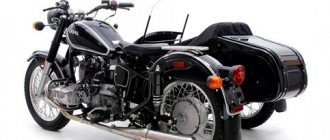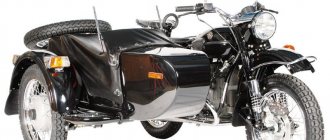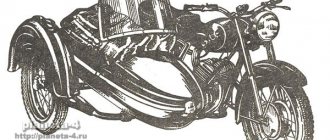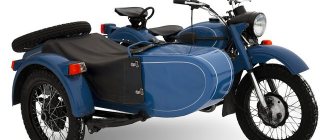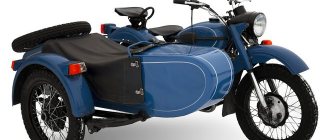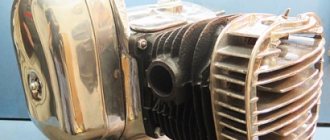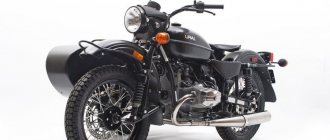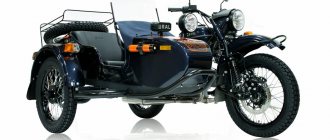At one time, the brainchild of the Irbit plant was in great demand. An excellent assistant in agriculture and serving as an excellent alternative to a car, the Ural had the ability to move on any road surface. The plant has currently stopped producing motorcycles. This happened due to a banal economic recession. In recent decades, the assembly of the Ural motorcycle engine has become an analogue of the German BMW-R71, as well as the stubborn competitor of the Dnepr.
The engine of the Ural motorcycle, the technical characteristics of which can easily compete with the new generation motorcycles, is subject to severe wear and tear. Therefore, owners often have to go through all the parts themselves and replace them.
The Soviet bike is considered a heavy motorcycle intended for rural work and transportation of goods. At the same time, it has relatively small but sufficient indicators. The Ural motorcycle engine on the Solo model produces 40 horsepower . And with boost you can achieve 55 hp. The maximum speed of the bike is 110 km/h. For such power, this is a rather modest figure, because the speed is greatly influenced by the mass of the motorcycle. However, the acceleration is quick and the bike's dynamics are very pleasant for the rider.
The engine capacity of the Ural motorcycle is 745 cm3, which makes it one of the largest in Russian production. In this case, the torque reaches about 4000 rpm . Such engines are typical for engines with gearboxes, rather than for boxer engines.
Peculiarities
Some models have hydraulic brakes. It is located at the rear of the wheel on the hub and provides confident braking even at high speed. The style of the bike is adjusted to wartime, especially the mirrors and fuel tank.
The engine of the Ural, a motorcycle whose characteristics do not differ only in power, has a number of advantages. Good cross-country ability due to the force commensurate with the mass allows you to easily move on loose or even wet soil. Therefore, movement in forested areas will not be difficult. Moreover, the Irbit plant provided excellent resistance to climatic conditions. The engine starts even at -30 degrees. However, in hot weather, prolonged use may cause overheating. In such cases, motorcyclists install forced cooling of the motorcycle engine.
Specifications
The engine of the Ural motorcycle was constantly modernized during the production process and its latest modification (2015) has technical characteristics of a modern level.
| INDEX | MEANING |
| engine's type | 4-stroke, overhead valve, opposed, two-cylinder |
| Engine displacement, cm cu. | 745 |
| Number of cylinders | 2 |
| Number of valves per cylinder | 2 |
| Maximum power (at 5600 rpm), l. With. | 40 |
| Maximum torque (at 4000 rpm), N*m | 52 |
| Cylinder diameter, mm | 78 |
| Piston stroke, mm | 78 |
| Compression ratio | 8.6 |
| Lubricant type | SAE 15W/40 |
| Lubrication system | Combined (pressure + spray) |
| Carburetor | K-37A, K-52, KEIHIN 32 CVK, L22A |
| Number of carburetors | 2 |
| Air filter element | JR 120047 (FM Filter A177) |
| Engine oil volume, l | 2 |
| Fuel supply system | injector |
| Average fuel consumption, l/100 km | 6.5 |
| Fuel | Unleaded gasoline A-92 |
| Crankcase gas recirculation system | Closed type with internal breather |
Repair and maintenance
Hearing another knock from the engine, the owners of the Russian motorcycle understand that the evening will be spent in the company of an iron friend. So it is with the Ural, frequent malfunctions are one of the features of the bike. Here are the main engine problems and their causes:
- The engine won't start. This happens in cases where:
- fuel does not flow into the carburetor (fuel supply system is clogged);
- no spark from the spark plug (breakage, carbon deposits or other reasons);
- violation of compression (lack of clearance in the valves, leaky fit or malfunction of the rings).
- uneven supply of fuel;
- water ingress;
- blockage in the fuel mixing system;
- problems with candles;
- violation of wiring integrity;
- capacitor failure;
- excessive amount of gasoline entering the air-fuel mixture.
- early spark supply;
- severe overheating of the motor;
- problems with pistons and rings (grinding, chipping, poor seal, etc.).
At the first sign of a breakdown, it is worth repairing the engine. Otherwise, you can worsen the situation and the cost of repair. To avoid malfunctions, you must follow the rules for operating and maintaining the motorcycle. It is even important how much oil to pour into the engine of a Ural motorcycle. Excess will interfere with work, and deficiency will contribute to wear of parts. It is also necessary to regularly replace filters , gaskets and other consumables.
In general, IMZ produced an excellent bike suitable for people of any age category. It is designed for both work and leisure. If you want to buy a motorcycle, Ural will be an excellent option on a low budget.
Weaknesses of the IMZ-8.103-10 (IMZ-8.103-30, M-67-36) engine of the Ural motorcycle
- Foot starter (kickstarter);
- Gas and clutch cables;
- Generator;
- Carburetors;
- Cylinder heads;
- Reverse gear (gearbox).
More details about the weak points of the motor...
Foot starter (kickstarter)
The foot starter of the IMZ-8.103-10 engine is a weak point due to the slippage of the pawl. The malfunction is eliminated after dismantling the gearbox and disassembling it with rearranging the pawl with the other side or replacing it. I have an assumption that the metal of the dog is of low hardness. On the other hand, if the pawl is made harder, the gear will fail. You need to choose the golden mean.
Throttle and clutch cables
The clutch control and fuel supply cables are a weak point due to their short service life. To put it simply, they tear, and before that they stretch, which makes it necessary to adjust the timing of the supply of the fuel mixture, as well as the clutch.
Generator
The generator does not run for a long time.
Carburetors
Gasoline gets into the floats, after which the cylinder is filled with gasoline. In addition, carburetors are not matched to these engines; half of the fuel goes to waste, which is not economical. It would be nice if the engine had one carburetor instead of two.
Cylinder heads
Do not overtighten the spark plug heads; the threads break off quite easily. You cannot overheat the engine, the result will be clearly visible on the heads, the studs are pulled out, leading to the landing plane of the heads. If you are unable to avoid breaking the spark plug thread, contact a familiar turner; he will be happy to repair it and install a steel threaded bushing for a modest fee. I can recommend the same for wear of valve seats and chamfers. It is much cheaper to repair heads than to buy new ones; a good turner can do this in no time.
Reverse gear (gearbox)
The reverse gear does not work for a long time due to the rapid wear of the reverse gear in the gearbox.
Engine head tuning
Through the channels of the engine heads, the cylinders are filled with a fuel mixture, and exhaust gases are released. The more efficiently the cylinders are filled and the exhaust gases escape more easily, the greater the engine power. To tune the Ural engine heads, you will need to remove the valves. The diameter of the original Ural valves is only 38mm inlet and 35mm exhaust, which affects the suffocation of the engine. Along with the valves, you need to press out the old valve seats and guides. The seats for the saddles should be bored to the size of the Dnieper saddles. New enlarged seats will allow the installation of larger diameter valves 40mm inlet and 38mm exhaust from the Dnieper. The best alternative to Dnepr valves would be valves from Audi. The quality of automobile spare parts is much higher, and thanks to the fixation with new type of crackers, the service life of the heads can be significantly increased. We recommend using bronze valve guides from VAZ 2101-2107.
Internal grooves improve lubrication of the valve stem. The movement of valves in them is the most efficient with minimal friction losses, and the service life is much longer. Bronze perfectly removes heat from the valve, which will have a positive effect on the stability of valve clearances.
It is important to know: when choosing valves, do not run into a fake. Exhaust valves made of heat-resistant steel should not be magnetized. Bronze guides are also not magnetic.
Please note that the gap between the guide and the valve stem is required from 0.04 to 0.06 mm. The valve should move freely in the bushing without dangling in it. By the way, we would like to note that the car guides have a seat for the oil seal. We strongly do not recommend installing it, since lubrication occurs by splashing oil, and not under pressure as in cars. After installing new valve guides, pay attention to the trimming of the valve seats. It is necessary to trim the seat along three chamfers: 60, 30 and 45 degrees, of which 45 degrees is the working one, which comes into contact with the valve plate, ensuring a tight fit. You will also have to replace the standard valve springs with automotive ones from the VAZ 2108. They are somewhat stiffer than the original ones, and are able to ensure smooth operation of the valves at high speeds. But keep in mind that with such springs, the camshaft is subject to accelerated wear - tuning a motorcycle engine requires sacrifice. The final procedure for tuning the heads is to bore the intake and exhaust channels with a cutter a couple of millimeters larger in diameter. At the same time, it will be possible to get rid of casting sagging and ensure better engine breathing. The exhaust channel should be polished to a mirror, and the intake channel should be left matte, slightly rough, to prevent fuel condensation on the walls. After tuning the heads, do not forget to blow out all the channels and hard-to-reach places with compressed air, and grind in the new valves. Grinding must be done manually using a two-component lapping paste. Never use a drill. A hose is put into tension on the opposite end of the valve stem, thus rotating the valve with your palms until you get a matte ring on the seat and valve plate with a thickness of 1.2-1.6 mm. Check the tightness of the valve by pouring keratin into the channels for 1-2 minutes.
Modifications of Ural 4320:
- Ural 4320 – chassis with a basic metal cabin with a load capacity of 7000-9000 kg;
- Ural 4320-19 – long-wheelbase chassis with a lifting capacity of 12,000 kg;
- Ural 43203 – chassis with reinforced front suspension;
- Ural 43204 – chassis with increased load capacity;
- Ural 44202 – truck tractor;
- Ural 43206 - chassis with a 4 by 4 wheel arrangement.
For cars, the Ural 4320 remains the base model. This truck is highly practical and designed specifically for the needs of the army. Its main area of application is the armed forces. However, the machine is also used in the public utilities, forestry, construction, mining and commercial sectors. Here it is in demand as an all-terrain vehicle used for transporting people and equipment.
Device
The basis of the car is a load-bearing riveted frame made of high-strength steel and characterized by increased rigidity. The design provides short rear and front overhangs, thereby increasing cross-country ability. The platform for transporting people and cargo is made of metal. It has lift-up side seats and an opening tailgate. The body assumes the possibility of installing an awning, arches and mounting sides on both sides. Some modifications received a wooden platform. The sides of the Ural 4320 are lattice or solid. The design provides for a front location of the unit. To access the engine, the hood opens upward. On the sides there are wide, flat fenders that protect the cabin from foreign objects and dirt while driving.
The truck has a 6 by 6 wheel arrangement. The model is equipped with single wheels with automatic adjustment of the air filling of the chambers on 3 drive axles. Recommended tires: 14.00-20 OI-25.
Ural 4320 has a dependent front suspension on semi-elliptic springs. It consists of 2-way shock absorbers. The rear suspension of the car is also dependent (on springs with reaction bars). All truck axles are drive axles. The steered wheels are located on the front axle.
The car is equipped with a friction clutch with a drive equipped with a pneumatic booster. The 2-speed manual transfer case has a permanently connected drive to the front axle. The Ural 4320 is equipped with a fully synchronized transmission produced by the Yaroslavl Motor Plant. The gearbox has 5 speeds, switched mechanically.
The brake system includes a dual-circuit working and single-circuit spare brake system. There is also an auxiliary braking system with pneumatic drive from the exhaust system. The mechanical parking brake system is equipped with a brake drum on the transfer case.
At the rear of the frame and at the front of the rigid bumper there are powerful towing devices made in the form of a towing mechanism and hooks. Thanks to this, the technical characteristics of the model were improved.
The developers of the Ural 4320 also took care of the driver. The steering in the latest models has a hydraulic booster. The cabin is equipped with a heater that maintains normal temperature in cold weather. The driver's seat is adjustable in 3 directions (up-down, forward-backward and backrest tilt). The instrument panel is located at a convenient distance from the driver. The instruments are easy to read, and the driver can reach the switches and buttons without getting up from the seat. The truck has a convenient and large glove compartment and a shelf for storing items. There is a document box under the passenger seats.
In the basic version, a 3-seater cabin made of stamped sheet metal is mounted on the frame. Thoughtful glazing guarantees good visibility and allows you to control the situation on the road. Large rearview mirrors also help with this.
Other types of cabins are also available:
- 3-seater all-metal 2-door cabin;
- 3-seater all-metal 2-door cabin with sleeping bag (this option is currently discontinued);
- modern spacious bonnet-type cabin with a sprung driver's seat and plastic tail;
- cabin based on the GAZelle Next module (3- and 7-seat versions are available).
Options include luxury cabins, a differential lock system, ABS, battery compartment insulation, an additional tank and a traction winch.
Camshaft tuning
This modification requires a very thoughtful approach; as a rule, a new cam shape is created experimentally and may not meet your expectations. A wide-phase camshaft will help to fully realize the capabilities of tuned cylinder heads. For moderate tuning, you can simply install it from the Ural model M 67-36. The photo below shows a wide-phase shaft on the left, and a regular one on the right.
If you want to achieve the maximum from the engine, then it is possible to increase the profile of the cams of the standard shaft. This can be done by welding the metal using argon welding. By increasing the width and height of the cams by a couple of millimeters, it is possible to achieve a shift in torque to the high speed region and increase power also by increasing the speed of the valve timing. Take into account the fact that such an engine will lose traction at low speeds and may even stall at idle. For this modification, we recommend finding a workshop or factory that can properly process the cam profile followed by carburizing. Then, it is important to make sure that the geometry of the shaft is even; there is a high probability that the shaft could be driven by a sharp temperature change; the curvature is checked with a dial indicator by an experienced turner.
Price of new and used Ural 4320
The cost of a new Ural 4320 car varies significantly depending on the version:
- chassis - from 1.9 million rubles;
- on-board version - from 2.1 million rubles;
- onboard vehicle with CMU – from 3.8 million rubles;
- tanker – from 3 million rubles;
- log carrier - from 2.8 million rubles;
- cargo-passenger version - from 3.1 million rubles.
There are relatively few used Ural 4320s available. Here prices range from 0.3 to 1.8 million rubles. The cost is influenced by the condition of the car, year of manufacture, area of use and equipment.
